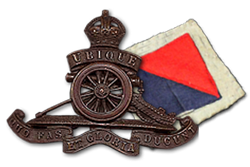Related Research Articles
The 202nd Independent Infantry Brigade (Home) was a short-lived Home Defence formation of the British Army during the Second World War.
26th (London) Anti-Aircraft Brigade was an Air Defence formation of the British Army during the Second World War. It defended London during the Blitz.
The 28th (Essex) Searchlight Regiment was a volunteer air defence unit of Britain's Territorial Army (TA) from 1935 until 1961, at first as part of the Royal Engineers, later in the Royal Artillery. During the Second World War it defended the approaches to London in The Blitz and Operation Diver before becoming a garrison unit in the liberation of Norway.
The 30th (Northumbrian) Anti-Aircraft Brigade was an air defence formation of Britain's Territorial Army from 1936 until 1955, which defended Tyneside and Sunderland during the Second World War.
The 31st Anti-Aircraft Brigade was an air defence formation of Britain's Territorial Army from 1936 until 1948. During the Second World War it defended West Yorkshire and later participated in the North West Europe campaign.

56th (Cornwall) Heavy Anti-Aircraft Regiment, Royal Artillery was a volunteer air defence regiment of Britain's Territorial Army (TA). Originally raised in 1920 as a medium artillery regiment, it was converted to the anti-aircraft role in 1932. During the Second World War, it was employed in Home Defence, in Iceland and then in India, where it was temporarily converted back to medium artillery. Postwar, it reverted to air defence until disbandment in 1955.
58th (Middlesex) Searchlight Regiment, Royal Artillery was an air defence unit of Britain's Territorial Army (TA) raised just before World War II. It defended the East Midlands of England during The Blitz, and later served as infantry in North West Europe at the end of the war, converting to the anti-aircraft (AA) artillery role postwar.

48th (Hampshire) Searchlight Regiment, Royal Artillery was an air defence unit of Britain's Territorial Army (TA) formed just before the outbreak of World War II from existing searchlight companies of the Royal Engineers. It served in Anti-Aircraft Command until 1944, including the Portsmouth Blitz and Operation Diver. At the end of the war it formed an infantry unit for garrison duties in liberated Europe. It continued in the postwar TA until AA Command was disbanded in 1955.

The 51st (Highland) Searchlight Regiment, Royal Artillery was a Scottish unit of Britain's Territorial Army (TA) formed for air defence just before World War II. It later served as an anti-aircraft (AA) artillery unit in the North West Europe Campaign 1944–45, and continued in the postwar TA into the 1950s.

The 84th Heavy Anti-Aircraft Regiment, Royal Artillery was an air defence unit of Britain's Territorial Army raised from employees of the London Passenger Transport Board during the period of international tension that preceded the outbreak of World War II. During the war it served in the Norwegian Campaign and the London Blitz, and later in Tunisia and Italy.
The 80th Anti-Aircraft Brigade was an air defence formation of the British Army during the Second World War. It landed on D-Day and saw action throughout the campaign in North West Europe, providing early warning of attacks by V-1 flying bombs against Antwerp during the winter of 1944–45.
The 76th Anti-Aircraft Brigade was an air defence formation of the British Army during the Second World War. It landed on D-Day and saw action throughout the campaign in North West Europe. Its guns operated in both anti-aircraft (AA) and ground roles in clearing and then defending the Scheldt Estuary until the end of the war.

The 103rd Heavy Anti-Aircraft Regiment was an air defence unit of the British Army's Royal Artillery during World War II. It saw action during the Liverpool Blitz, landed on D-Day and served throughout the subsequent campaign in North West Europe and defended the cities of Belgium against V-1 flying bombs.

The 73rd Light Anti-Aircraft Regiment, was an air defence unit of the British Army's Royal Artillery during World War II. It served during the London Blitz, landed on D-Day, seeing action throughout the campaign in North West Europe and defending the cities of Belgium against V-1 flying bombs.
The 93rd Light Anti-Aircraft Regiment was an air defence unit of the British Army's Royal Artillery (RA) during World War II. Elements of the regiment landed with special equipment on D-Day, and served in the Normandy campaign. The regiment went on to defend Belgian cities against V-1 flying bombs and participated in the assault crossing of the Rhine.

The 9th Anti-Aircraft Division was an air defence formation of the British Army during the middle years of the Second World War. It defended South Wales and the Severn Valley during The Blitz but only had a short career.

The 10th Anti-Aircraft Division was an air defence formation of the British Army during the early years of the Second World War. It defended Yorkshire and Northern Lincolnshire during The Blitz and the Baedeker Blitz but only had a short career.

The 118th Light Anti-Aircraft Regiment, Royal Artillery, was an air defence unit of the British Army during World War II. Initially raised as an infantry battalion of the Gloucestershire Regiment in 1940, it transferred to the Royal Artillery in 1942. It served in Home Forces and then went to Assam to defend Fourteenth Army's vital bases and airfields during the Burma Campaign until it was broken up in 1944.

The 103rd Light Anti-Aircraft Regiment, Royal Artillery, was an air defence unit of the British Army during World War II. Initially raised as an infantry battalion of the East Lancashire Regiment in 1940, it transferred to the Royal Artillery in 1941. It served in Northern England and Northern Ireland but saw no active service. Shortly before D Day, it was broken up to reinforce other units that fought in the campaign in North West Europe.

The 104th Light Anti-Aircraft Regiment, Royal Artillery, was an air defence unit of the British Army during World War II. Initially raised as an infantry battalion of the South Staffordshire Regiment in 1940, it transferred to the Royal Artillery in late 1941. It served in the Middle East and Italy until it was disbanded for infantry reinforcements in 1944.
References
- Joslen, H. F. (2003) [1990]. Orders of Battle: Second World War, 1939–1945. Uckfield, East Sussex: Naval and Military Press. ISBN 978-1-84342-474-1.
- N.W. Routledge, History of the Royal Regiment of Artillery: Anti-Aircraft Artillery 1914–55, London: Royal Artillery Institution/Brassey's, 1994, ISBN 1-85753-099-3.